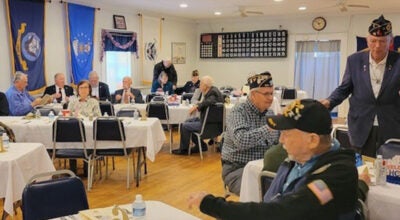Critical Race Theory debate comes home
Published 5:04 pm Friday, June 25, 2021
|
Getting your Trinity Audio player ready...
|
The nationwide debate over Critical Race Theory and what place it should have in public schools has now come to Isle of Wight County.
The term — often abbreviated CRT — refers to the study of how American law has perpetuated social, economic and political inequalities among minority groups, not necessarily exclusive to race or limited to intentional acts of racism, according to American Studies and Africana Studies professor Dr. Jamel K. Donnor of the College of William & Mary.
Over the past several months, the decades-old academic discipline has become a political talking point, with a number of Republican-led states proposing to ban the teaching of the concept in K-12 schools. In May, Georgia Gov. Brian Kemp called the concept a “divisive and anti-American curriculum.” On June 10, Florida Gov. Ron DeSantis wrote on Twitter that CRT would teach children “to hate our country and hate each other.”
Isle of Wight County’s School Board heard similar remarks at its June 10 meeting.
“Who decided that the county of Isle of Wight needed a Critical Race Theory coordinator?” asked Heidi Schwartz, the parent of an IWCS student, referring to the division’s hiring of Kiyaana Cox-Jones this past January.
Jones’ official title is coordinator of equity and inclusion.
Others say language the Virginia Department of Education is using to describe its statewide EdEquityVA initiative, specifically what it means to be “anti-racist,” is essentially Critical Race Theory.
The department’s “anti-racism in education” document, available on its website, states racism “goes far beyond individual instances of mistreatment due to skin color” and that the focus of an anti-racist education agenda “should instead be on interrogating and dismantling the system of social structures that produces cumulative, durable, race-based inequalities.”
“I believe this initiative seeks to make white children feel as if they are oppressors,” said Monette Brooks, a retired Isle of Wight teacher.
“This idea is socialism,” said Jason Maresh, another parent. “This ideology is divisive in nature and is in fact the very racism that it claims to remove.”
School officials maintain that Critical Race Theory isn’t a part of Isle of Wight County’s curriculum.
“I know Critical Race Theory is on people’s minds; I know it’s on the news every day … I see Loudoun County, Virginia on the news every day, and I know that hits close to home,” said Superintendent Dr. Jim Thornton.
Thornton refers to a June 12 anti-CRT rally that took place outside Loudoun County’s government complex in Leesburg, which included remarks by Ian Prior, a former Trump administration official who is now leading an effort to recall six of the nine Loudoun School Board members.
Jones has prepared teacher training seminars to inform Isle of Wight’s faculty and staff of the new equity terminology being used at the state level and to “give them another lens to look at each student’s needs,” Thornton said.
But “we are not teaching students about equity and inclusion,” he assured.
The training will take place over the first semester this coming school year, Thornton said, and will include an examination of school data through an equity lens to identify and address achievement gaps that persist for some student demographics.
“We are not asking teachers to implement anything into our curriculum or discuss any of these ideas with students, in fact they will be instructed to use this training for their own awareness and not for anything else,” Thornton said.
Still, “students may come and say, ‘Mr. So-and-So, what is Critical Race Theory?’” Thornton had previously told a crowd during a meeting of the Southern and Central Isle of Wight Citizens Group May 19. “I want them to be able to answer that in what its definition is, not their political opinion.”
Isle of Wight County’s NAACP chapter is also pushing back against what it considers to be mischaracterizations of CRT. On June 14, the chapter hosted a virtual meeting with Jonathan Zur, executive director of the Virginia Center for Inclusive Communities, to provide an overview of what CRT is and is not. About 10-20 people attended.
“It’s not that scary,” said Zur, whose organization works with Virginia schools and other organizations looking to implement diversity initiatives.
The VCIC isn’t working with Isle of Wight County Schools, Zur said, nor has it been approached by any school or district in Virginia to conduct programs using CRT.
“That said, the public focus on critical race theory in the last 2-3 months has resulted in a lot of questions from VCIC partners around Virginia on the topic, so our staff team has been internally educating ourselves to be able to effectively answer questions and provide clarity,” Zur said.
One of the key tenets of Critical Race Theory, Zur explained, is the idea that race is a social construct, meaning it’s not biological; it’s something humans invented.
“How do we know that race is a social construct? … Look at the United States Census,” Zur said. “Every 10 years in our country the names of different [racial] categories change. If race was something that was official and scientific, we wouldn’t see the labels and the groupings change every 10 years.”
There are also instances where the same person can have a different race listed on his or her birth certificate compared to his or her death certificate. The reason for this, Zur explained, is when a woman gives birth, she’s often asked by a nurse or doctor to state the baby’s race, which is then entered on that child’s birth certificate. If that same person, upon death, has an autopsy completed, the coroner makes a visual guess as to the race of the deceased, which gets listed on that person’s death certificate.
“They are not checking anything scientific,” Zur said. “They are not taking blood, they are not doing anything like that.”
Racism, however, and its consequences are very real, Zur said. But there are two separate understandings of the term that have emerged in American society.
In one of the earliest published uses of the phrase “white privilege,” Peggy McIntosh, an American feminist and anti-racism activist, wrote in 1989 that she’d been taught racism was “individual acts of meanness.”
“So based on what she was taught and based on what a lot of people are taught, racism is … calling someone a name, being actively biased towards a person based on their race, actively excluding someone based on their race, not hiring someone based on their race, things like that,” Zur said. “So that would be an isolated individual interaction where somebody is mean to someone else … There’s a large population in this country that believes that that is how racism is defined.”
Proponents of Critical Race Theory, however, believe racism is more than just “individual acts of meanness” and has played a role in the systems and structures of American life, resulting in different outcomes for whites versus people of color.
“Can you think of the last time you saw a headline that said ‘First white male achieves X,’ ‘First white male named Y?’” Zur asked, rhetorically. “We don’t see that as a headline. What we do see is ‘First Black male earns doctorate from X university and X program,’ ‘First Black woman named superintendent of school,’ those types of things. And so the fact that we still see that today means that we inherit the residue of past policies, practices, structures. That is what those who are defining racism more at a structural or systemic level would say.”
The two ideological camps aren’t in agreement with regards to what children should be taught in school and how teachers should be trained to field questions from their students on controversial issues like race relations.
“Somebody who teaches their child, ‘We are all the same, I am colorblind’ and, ‘Don’t call anyone a mean name because of their race,’ who then is told, ‘Well, actually racism is pervasive in our society and shows up in terms of policing, it shows up in housing, it shows up in education, it shows up in terms of wealth, etc.’ That’s hard to work through, because we have somebody who sees and understands this concept as one thing and is now being told it’s something else,” Zur said.
“Broadly, Critical Race Theory is a practice that says we need to understand how somebody’s race can be determinative of their experiences and outcomes … instead of the law saying, ‘Well, you didn’t overtly discriminate, so therefore there is not a case of discrimination here,’ it says we need to look at patterns that create different outcomes, so if we see there are different patterns in terms of hiring that result in certain identities being hired more than others … something’s going on there that you need to interrogate,” Zur said. “That’s what Critical Race Theory, at a very basic level, would say. … The emphasis is on how structures and systems perpetuate different experiences, rather than individual actions.”
For schools, this type of lens can come into play when looking at who is and isn’t getting disciplined, Zur said. But CRT isn’t being taught in K-12 schools to any large or division-wide extent anywhere in Virginia, he assured.
And CRT shouldn’t be confused with what he termed “culturally relevant pedagogy,” sometimes also referred to as culturally relevant teaching or culturally responsive teaching, which is being practiced at Virginia schools. An example of this culturally responsive teaching, Zur said, might take the form of a teacher pointing out that the U.S. Declaration of Independence includes the phrase, “We hold these truths to be self-evident, that all men are created equal,” and asking his or her class if that was actually true of American society of the time.
“How about today? Do we see that everyone is treated equally in our society or do different people have different experiences? Let’s explore that together,” Zur suggested the teacher might say. “Now I don’t know about you, but if I knew young people were having that conversation, that’s not scary to me. The sky’s not going to fall.”
As for an alleged link between CRT and Marxism, “I don’t see there being overlap or significant concern there,” Zur said. “I’m just not sure I see the link.”
The VCIC, he explained, originated during the 1930s when it was founded as the National Conference of Christians and Jews. At the time, its diversity initiatives included events like “national brotherhood week,” which U.S. presidents and other national leaders leveraged as a foil to Marxism and Communism.
“And so it’s interesting that today, that it’s being labeled in the ways that it is … I don’t think our work in terms of the values that we have promoted and engaged is significantly different today than it was 30, 40, 50, 60 years ago,” Zur said. “Certainly the issues have evolved, but the core values are very much the same.”




